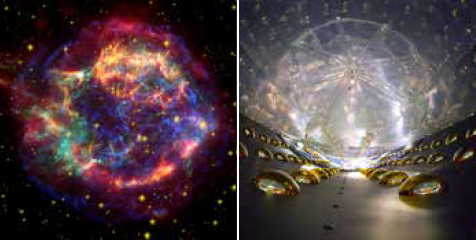The explosion drama starts in the murky midst of the stellar envelope surrounding the core. It can take some time — hours or even a good fraction of a day — for a shock wave to burst out of the dead star’s corpse and start the shining of the supernova. Long before the visible fireworks, nearly all the energy of the star’s inward tumble has already escaped, in the form of nearly invisible neutrinos.
Neutrinos are elementary particles that are famously “ghostly” — they only rarely bump into matter, so they’re difficult to detect. On average, a neutrino will travel through a light-year of matter before colliding with an atom! In the ferociously hot and dense matter at the heart of the star’s collapse, neutrinos are produced in huge quantities. Because neutrinos just slip through matter like phantoms through walls, they can escape the star within a few tens of seconds. On Earth, we can capture a burst of them (which is only a tiny fraction of the total produced) in huge underground neutrino detectors, before the supernova’s light shows up.
You can sign up with the Supernova Early Warning System network (https://snews.bnl.gov) to get an alert when this happens from the neutrino detector network.
Kate Scholberg
Professor of Physics,
Duke University,
Durham, North Carolina










